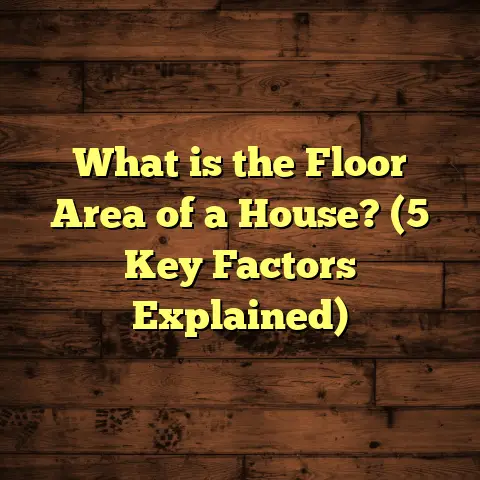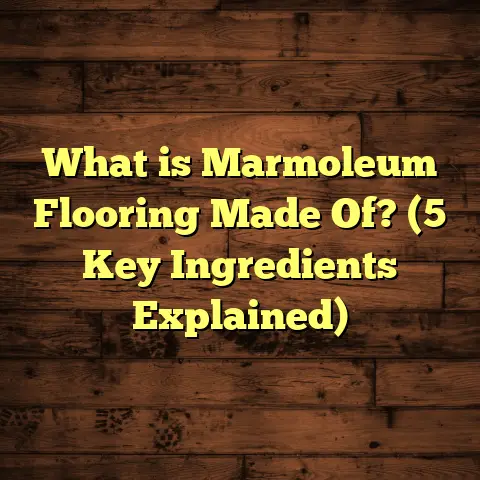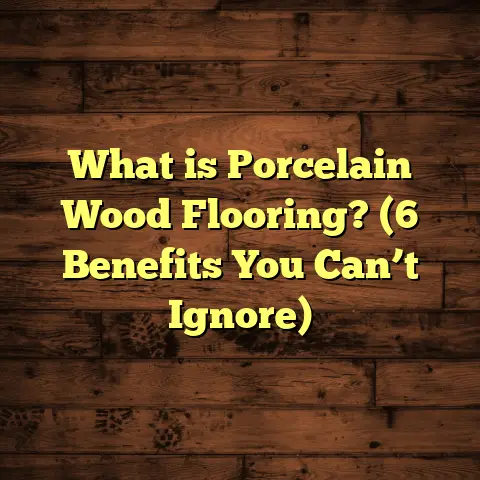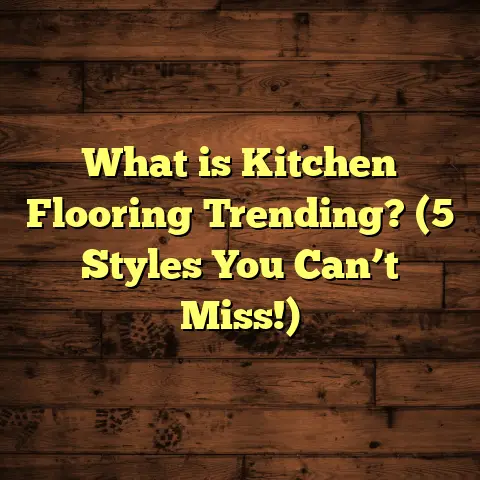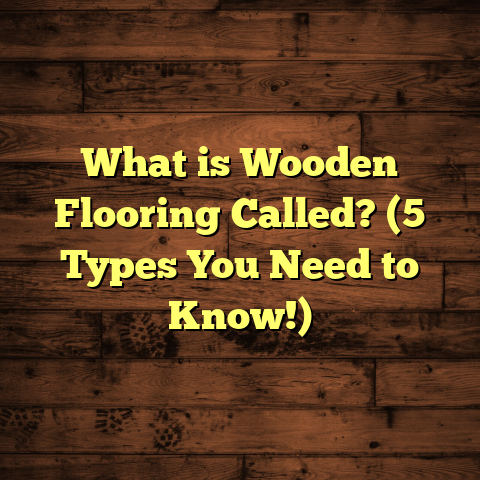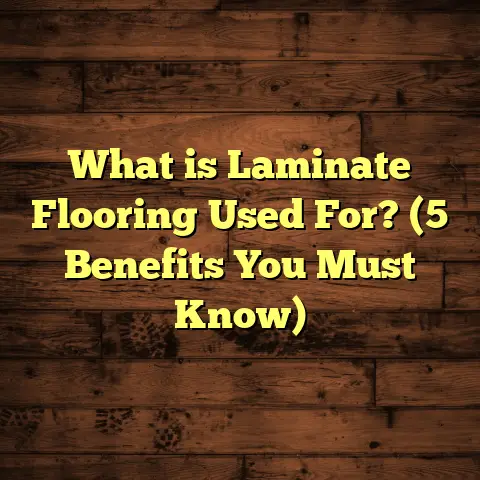What is LVP Flooring? (5 Benefits You’ll Love Instantly)
I remember the first time I installed LVP flooring in my own home. What really struck me was how incredibly easy it was to keep clean. I’m talking about those moments when life gets messy—kids running in from the rain, pets tracking mud, or an accidental spill of coffee or wine. With LVP flooring, a quick sweep or a damp mop is all it takes to bring things back to looking spotless. No special cleaners, no worrying about water damage like you would with hardwood, and definitely no stressing over scratches showing up. That convenience alone made me a huge fan right away. If you’re wondering what exactly LVP flooring is, why it’s such a popular choice, and what benefits it offers that could make your life easier and your home look fantastic, I’m here to walk you through everything based on my years of experience as a flooring contractor and homeowner.
What is LVP Flooring?
Let’s start with the basics. LVP stands for Luxury Vinyl Plank flooring. At its core, it’s a type of vinyl flooring designed to look just like real wood or stone but with some serious advantages that make it stand out from traditional options like hardwood or laminate.
You might wonder: How can vinyl look so realistic? Well, LVP is created using multiple layers. Here’s how it breaks down:
- Wear Layer: This is the top protective coat that guards against scratches, stains, and dents. It’s usually made from a transparent urethane or aluminum oxide layer that keeps your floor looking fresh.
- Design Layer: This is where the magic happens visually. High-resolution printing technology replicates the grain patterns and textures of natural wood or stone. Some planks even have embossed textures you can feel underfoot.
- Core Layer: The core gives the plank stability and durability. There are different types of cores—some more flexible, some rigid like WPC (Wood Plastic Composite) or SPC (Stone Plastic Composite). Each core type offers different levels of strength and water resistance.
- Backing Layer: This adds support and sometimes moisture barrier qualities.
LVP looks like hardwood but doesn’t have the same vulnerabilities. Unlike hardwood floors, LVP doesn’t warp or swell when exposed to water, making it perfect for kitchens, bathrooms, basements, or anywhere moisture might be an issue.
I’ve installed LVP in everything from cozy cottages to modern condos, and each time I’m impressed by how adaptable it is. Plus, it’s quieter and warmer underfoot than tile—something I personally appreciate when I’m barefoot in the morning.
A Bit of History Behind LVP
Vinyl flooring has been around since the mid-20th century, originally as sheets that were affordable but didn’t look very natural. As technology evolved, manufacturers started developing luxury vinyl products to meet demand for more stylish and durable floors.
The “luxury” part refers to the higher quality materials and enhanced visuals. By 2010, LVP had become a staple in residential and commercial flooring markets due to its blend of beauty and practicality.
5 Benefits You’ll Love Instantly
1. Easy Maintenance That Saves You Time and Effort
If you ask me, this benefit alone makes LVP worth considering for almost any home. Having floors that don’t require special treatments or constant upkeep is a game-changer.
When my kids were toddlers, I remember cleaning up spilled juice or food crumbs way more often than I’d like to admit. Before switching to LVP, our hardwood floors would get sticky spots that needed special cleaners and careful drying to avoid damage. With LVP? A quick wipe down with a damp mop was enough.
Here’s some data that might interest you: According to a report by HomeAdvisor, homeowners spend on average 1-2 hours per week cleaning their floors depending on the type. Vinyl floors reduce that time by about 30% because they don’t trap dirt as easily and don’t require polishing or refinishing.
Cleaning tips I’ve shared with clients:
- Use a soft broom or vacuum with a hard floor setting.
- Avoid abrasive scrubbers or harsh chemicals.
- Mop with warm water plus a mild detergent occasionally.
- Clean up spills immediately to prevent staining but don’t worry about water damage.
One client told me she likes how her new LVP floor doesn’t show pet hair as much as her old carpet did—so her daily cleanup feels lighter too.
2. Water Resistance That Protects Your Investment
Water damage is one of the biggest enemies of many flooring types. Hardwood can warp, laminate can peel up at the seams, and carpet gets ruined fast. This is why LVP shines in rooms prone to moisture.
I once helped a family renovate their basement where humidity was always an issue. They wanted something warm and inviting but also practical. After installing rigid-core waterproof LVP, they no longer stress about minor leaks or dampness ruining their floors.
The Resilient Floor Covering Institute mentions that vinyl floors have less than 0.5% moisture absorption rate compared to wood’s 5-10%. What does that mean for you? Your floor stays flat and intact even if water sits on it briefly.
Another homeowner I worked with had a toddler who frequently spilled milk and water in the kitchen. She swears by her waterproof LVP because she doesn’t have to rush to mop every little spill in fear of warping floors.
3. Realistic Designs That Impress Everyone
I can’t tell you how many times clients have said they can’t believe their LVP isn’t real hardwood after installation. The design layer has come a long way thanks to advanced printing technology.
There are planks mimicking oak, hickory, maple—you name it—with grain patterns so detailed they almost fool your eyes up close. Some brands also include embossed surfaces so you can feel the texture just like natural wood.
Here’s a fun fact: A survey by Flooring America found that 78% of homeowners rated modern LVP as equally or more attractive than engineered hardwood.
I’ve personally seen how this makes a difference when selling homes too. Buyers often comment on how beautiful and modern the floors look without the high price tag of hardwood.
If you want something different from wood, there are also stone-look vinyl planks that replicate marble or slate perfectly.
4. Durability That Handles Life’s Everyday Challenges
If you have kids or pets—or both—you know how floors can take a beating daily. Scratches from shoes, dents from dropped items, stains from food accidents: these are just part of life.
What I love about LVP is its ruggedness. The wear layer thickness usually ranges between 6 mils (for light residential use) up to 20 mils (for heavy traffic commercial spaces). For most homes, a 12–20 mil wear layer means your floor will stay looking great for years.
I recently worked on a rental property where tenants had dogs and kids running around constantly. We installed commercial-grade 20 mil wear-layer LVP, and after two years there were zero complaints about scratches or dullness.
Independent tests show high-quality LVP can withstand over 2 million foot traffic cycles without visible wear—far beyond what typical home use demands.
5. Affordability Without Compromising Style
Budget is always a major factor when thinking about flooring. Hardwood floors are gorgeous but typically cost between $8–$15 per square foot installed depending on species and finish.
Laminate is cheaper but often doesn’t hold up well around moisture or heavy use.
With LVP ranging from $2–$7 per square foot installed, you get a cost-effective option that delivers durable beauty without breaking the bank.
When I renovated my own home’s floors recently, choosing LVP allowed me to cover more rooms within my budget while still achieving a rich look I was proud of.
Here’s a simple comparison:
| Flooring Type | Avg Installed Cost per sq.ft | Water Resistance | Maintenance |
|---|---|---|---|
| Hardwood | $8 – $15 | Low | High |
| Laminate | $3 – $8 | Low-Medium | Medium |
| Luxury Vinyl Plank | $2 – $7 | High | Low |
| Tile (Ceramic/Porcelain) | $5 – $15 | High | Medium |
Personal Stories & Lessons Learned From My Projects
Story 1: The Kitchen Disaster Turned Win
A client once told me about how she had nearly given up on renovating her kitchen floor because she feared water damage from cooking spills and occasional leaks under the sink.
We discussed options but she wanted something visually warm like wood yet practical.
After installing waterproof LVP with a rigid core and thick wear layer, she called me weeks later raving about how easy cleanup was after parties and how no stains showed even after wine spills!
She mentioned this was her first time not worrying about damaging the floor from everyday mishaps—and it felt like freedom.
Story 2: DIY Success With Minimal Fuss
I helped my sister install LVP in her new apartment last year. We chose click-lock planks that didn’t require glue or nails. Over one weekend we transformed her living room floor without stress.
She was amazed at how straightforward it was for someone without much experience in flooring.
Since then, she tells me she loves how warm and quiet it feels compared to her previous laminate flooring.
Story 3: Commercial Use That Surprised Me
I once worked on renovating an office space where durability was key due to constant foot traffic but budget was tight.
We went with commercial-grade LVP with enhanced wear layers and anti-slip surfaces.
The building manager reported zero issues after two years despite thousands of people walking daily.
This project reinforced my confidence that LVP can thrive even under demanding conditions.
Installation Insights: What You Should Know
Installing LVP is one of the reasons it’s so popular among homeowners and contractors alike. It’s less labor-intensive than hardwood or tile installations since many products feature floating floor systems with click-lock edges.
Here’s what I’ve learned over hundreds of installs:
- Preparation is key: Make sure your subfloor is clean, dry, and level.
- Acclimate your planks: Let them sit in the room for at least 48 hours before installation so they adjust to temperature and humidity.
- Use underlayment if needed: Some LVP products have built-in underlayment; if not, adding one can improve comfort and sound absorption.
- Cutting planks: A utility knife usually does the trick for straight cuts; a jigsaw helps for curves.
- Expansion gaps: Leave small gaps at walls for expansion; these get covered by baseboards or molding.
- DIY-friendly: If you’re handy with tools, installing LVP yourself can save money; otherwise, professional installers can finish quickly due to ease of handling.
Common Questions About LVP Flooring
Is LVP flooring slippery?
Most modern LVP has textured surfaces that reduce slipperiness even when wet. Some brands offer extra grip finishes perfect for households with kids or elderly members.
How long does LVP last?
With proper care, high-quality LVP can last 15-20 years or more—sometimes longer than laminate floors depending on wear layer thickness.
Can I install LVP over existing flooring?
Often yes, as long as the existing floor is flat and stable (like vinyl sheet or tile). Always check manufacturer recommendations.
Is it environmentally friendly?
Vinyl production involves plastics which aren’t biodegradable. However, some brands offer recycled content products and have recycling programs.
Final Thoughts
Choosing flooring is a big decision because it impacts your home’s look and feel every day. If you want something that’s easy to clean, tough against water damage, visually stunning, durable under real-life use, and budget-friendly—I truly recommend giving Luxury Vinyl Plank flooring serious consideration.
It’s become my go-to suggestion not only because of its practical benefits but also because I love seeing how happy it makes homeowners knowing they picked something smart for their lifestyle.
Thinking about trying out LVP? Feel free to reach out if you want advice on styles, installation tips, or maintenance tricks—I’m here to help make your flooring journey smooth and enjoyable!
